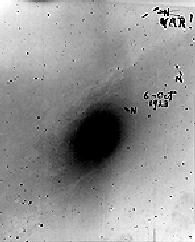Credit & Copyright: Mount Wilson Observatory
Historical Archive
Explanation:
In the 1920s, using photographic plates made with the
Mt. Wilson Observatory's 100 inch
telescope, Edwin Hubble
determined the distance to the Andromeda Nebula -
decisively demonstrating the existence of
other galaxies far beyond the Milky Way.
His notations are evident on
the plate shown above
(the image is a negative with stars appearing as black dots against
the white background of space).
By intercomparing plates, Hubble
searched for "novae", stars which underwent a
sudden increase in brightness.
He found several on this plate and marked them with an "N".
Later he discovered that one was actually a type of
variable star known as a cepheid -
crossing out the "N" he wrote "Var!" (upper right).
Thanks to the work of Harvard
astronomer Henrietta Leavitt, cepheids,
regularly varying, pulsating stars, could be used as
"standard candle" distance indicators.
Identifying such a star allowed Hubble to show
that Andromeda was not a small cluster of stars and gas within our own
galaxy, but a large galaxy in its own right at a substantial
distance from the Milky Way.
Hubble's discovery is responsible for our modern concept of a
Universe filled with galaxies.
Information:
The
Scale of the Universe Debate in April 1996
1999 2000 2001 2002 2003 2004 2005 2006 2007 2008 2009 2010 2011 2012 2013 2014 2015 2016 2017 2018 2019 2020 2021 2022 2023 2024 2025 |
Январь Февраль Март Апрель Май Июнь Июль Август Сентябрь Октябрь Ноябрь Декабрь |
NASA Web Site Statements, Warnings, and Disclaimers
NASA Official: Jay Norris. Specific rights apply.
A service of: LHEA at NASA / GSFC
& Michigan Tech. U.
|
Публикации с ключевыми словами:
Andromeda - Андромеда - Переменные звезды - Цефеиды - Хаббл
Публикации со словами: Andromeda - Андромеда - Переменные звезды - Цефеиды - Хаббл | |
См. также:
Все публикации на ту же тему >> | |
